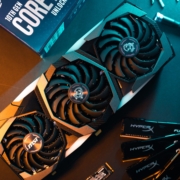Can Gelsinger restore the rule of Moore’s Law?
On Jan. 13 news broke that Intel CEO Bob Swan will retire and be replaced by Intel alum and current VMware CEO Pat Gelsinger, effective Feb. 15. Although Intel is facing challenges and has suffered setbacks in the last few years, it would be an exaggeration to say the company is in trouble. It dominates PC and server CPUs market share and extracts much greater profits from those devices than do their manufacturers.
Despite share gains by AMD, Intel’s hegemony over the x86 instruction set and its related silicon will assure continued profits for many years, as any transition in such critical components is slow and careful. Swan came to the corner office when Intel was struggling with issues that have persisted, and, in some cases, intensified. Some of these challenges have been self-inflicted from an inside-out perspective, while others have been outside-in threats that internal deficiencies have compounded. Notwithstanding, a growing number of activist investors have been pressuring Intel’s board for leadership change.
The inside-out challenge is to marry manufacturing scale and agility
Intel has enforced the rule of Moore’s Law on the industry for years. Faster, better, cheaper form factors have almost single handedly underpinned the digitization of business and the consumerization of IT throughout much of our daily lives. The inexorable march has seen the rapid rise and fall of business entities as proprietary minicomputer architectures gave way to the Microsoft Windows/Intel CPU, or Wintel, juggernaut that enjoyed a near virtual lock on the market. Intel built its share dominance on two core best practices: chip design and manufacturing.
Each new generation of CPUs requires both a thorough redesign and a massive technically challenging improvement in the chip manufacturing process. For decades, Intel has relied not only on its technical skills but also on its massive revenue to stay ahead of competitors. Other chip vendors rely on third-party chip factories, called foundries. Over the past three years, the main independent foundry, Taiwan Semiconductor Manufacturing Company (TMSC), has outperformed Intel, as has Samsung. The technology race in chip manufacturing is closely related to the thinness of the substrate. Intel has not yet produced its promised 7nm chip, and its current road map states it will not produce 5nm chips until 2023; whereas TMSC and Samsung produced 5nm chips in sample quantities in 2019.
Because of the delay in manufacturing technology, Intel has not been able to meet demand, resulting in PC vendor backlogs. These backlogs have been beneficial for PC vendors, reducing price competition and increasing margins. Intel margins are down, but not severely. The constrained supply made it easier for Intel’s main competitor in PC CPUs, AMD, to gain market share, but because of buyer conservatism and the long lead time necessary to design new PCs, the erosion has been small.
On the server side, Intel has to embrace a more agile manufacturing philosophy and a willingness to essentially become a contract manufacturer of third-party designs as the consolidated Wintel form factor gives way to multiple designs in what is commonly called accelerated computing. At the same time, market uniformity and scale are also giving way. Powerful, small, low-cost form factors are going to proliferate as digitization continues. Edge compute and various smart things will contribute to this shift, and the ability to run smaller manufacturing runs will become paramount.
Revamping Intel’s development process and pivoting to more agile manufacturing will be two core internal challenges confronting Gelsinger, but not the only ones. The outside-in pressures will mount as well.




Leave a Reply
Want to join the discussion?Feel free to contribute!